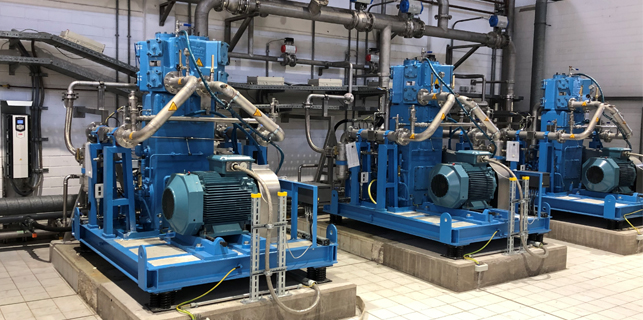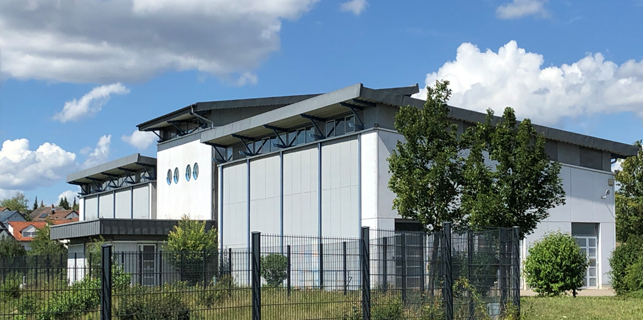In the Ammertal-Schönbuchgruppe (ASG) association’s Ammerbuch-Poltringen waterworks in Germany, IE5 motor and variable speed drive (VSD) packages are driving compressors to soften clean water in the water treatment system. The ABB energy-efficient motor and VSD solution is an important component in the energy management process for this clean water supplier in the region of Swabia.
Hard water that contains lime is not harmful to a person’s health, but the side effects on products and facilities can be annoying. When the water dries it can leave stains on the fittings in the kitchen and the bathroom, and limescale deposits can be seen inside kettles. In Germany, when the softness level of water is measured at 14 degrees, it is considered hard water.
The Zweckverband Ammertal-Schönbuchgruppe (ASG), whose association area is southwest of Stuttgart, gets its raw water from twelve deep wells. The water softness is 28 to 32 degrees, which is considered very hard water in Germany. Before the drinking water is supplied to consumers, the water must be softened to a medium hardness level, via a central softening process that takes place at the Poltringen waterworks. During the softening process, a number of metals are removed from the water, which helps extend the lifetime of the plumbing, pipes and fittings. The raw water that is pumped from the deep wells is stored in a raw water tank. From there, it is pumped into the water softening system, where the hardness of the water is reduced to a maximum level of 13.5 degrees.
In the water softening system, up to 600 cubic meters of water can be softened every hour. This corresponds to a maximum daily output of 14,400 cubic meters of the waterworks’ average daily water output.

Synchronous reluctance motors for eluate compressors
In the water softening system, the raw water is softened using an ion exchange process. If the ion exchangers are saturated, they undergo a cleaning process, for which carbon dioxide is required. Unused gaseous carbon dioxide is compressed in the recovery process and returned to the CO₂ tank. “Eluate compressors, which are driven by ABB’s IE5 synchronous reluctance motors, have been in use since 2016. The ABB wall-mounted ACS880 industrial drives control the speed and torque of the 55-kilowatt motors.
Jochen Rausch is responsible for the electrical engineering and energy management at the association. He explains: “We have a relatively large number of machines in use, so electricity usage is a focus for us. In 2012, ASG introduced an energy management system that is certified in accordance with DIN EN ISO 50001. From 10 million kilowatt hours in 2013, we have now reduced the annual energy consumption to 6.8 million kilowatt hours. The ABB motor drive packages are part of our efforts to further reduce energy consumption. "
Very good experience with the motor drive package
The water softening system has two lines, with one eluate compressor per line. For redundancy reasons, a third compressor is also available, which can serve both lines if required. The compressors run for a total of 15 to 18 hours per day. Each running process runs for four to five hours. Once the cleaning process has been completed, the compressors stand by until an ion exchanger needs to be cleaned again.
ASG is one of the early adopters of ABB’s synchronous reluctance motors. Jochen Rausch gives the drive packages good feedback after four years of operation: “The motors and VSDs harmonize very well. Despite the frequent start-up and shutdown phases, the motors have yet to have any bearing problems or failures. "
In addition to the super premium efficiency, the low level of heat from the motor is important, as it does not require a cooling system in the engine room. Since no rotor currents occur in a synchronous reluctance motor due to the rotor geometry, the rotor losses are completely eliminated, which in an asynchronous motor can account for up to 40 percent of the total loss. Also associated with the lower losses is a lower heat dissipation from the motor. With the old engines, the room temperature was very high during the summer due to the heat from the waste heat of the motors. This made cooling the compressors difficult.
The compact design of the ABB synchronous reluctance motors is another advantage for Jochen Rausch. Since the machines in the system are mounted on prefabricated sub-frames, the construction effort for the frames and machine foundations are lower.
According to Jochen Rausch, it is hardly possible to make a comparison between the predecessor motors and the new ABB motors in terms of energy savings, because the previous motors had more than twice as much power as the current synchronous reluctance motors. Furthermore, the compressor technology was different. If you take conventional asynchronous motors in the waterworks for comparison, Rausch estimates the energy savings through the IE5 synchronous reluctance motors to be up to a third.

Important functions of the variable speed drive
Since the produced amount of carbon dioxide varies, depending on the status of the process and the cleaning process, the ACS880 VSD has a large control range. A smooth setpoint control is also important, because the setpoints are given to the devices via the control system. Another important function of the devices is the speed suppression, as there used to be problems with resonance frequencies in the water softening system. These can place a lot of stress on the piping systems connected to the compressors. The speed skip function of the VSD is used for applications in which certain motor speeds or speed ranges must be avoided due to mechanical vibration problems. It prevents the setpoint from fluctuating in a critical speed range for a long time.
Jochen Rausch emphasizes the high level of user-friendliness of the ABB VSDs: “The service technician can quickly see the readings of the variable speed drive via the PC tool connected to the VSD. I also find the VSD control unit’s multilingual display easy to understand and use. It is removable and can be easily changed if necessary. "